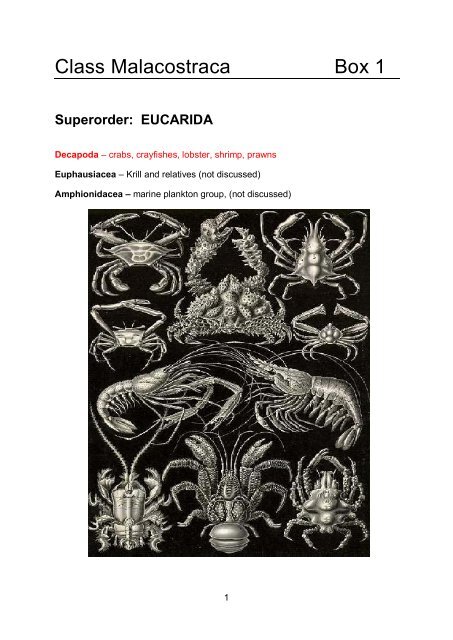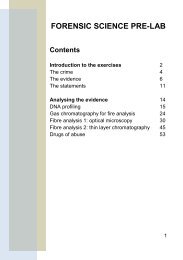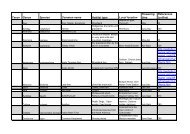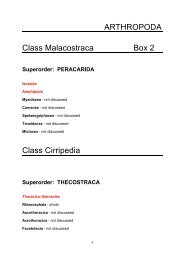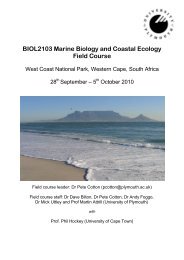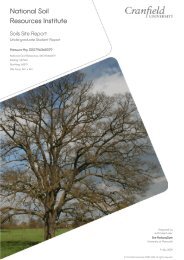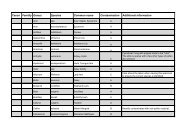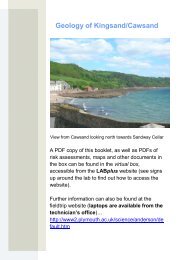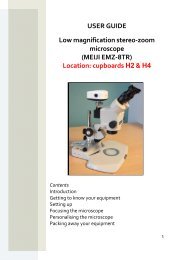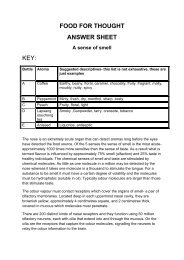Class Malacostraca Box 1
Class Malacostraca Box 1
Class Malacostraca Box 1
- No tags were found...
You also want an ePaper? Increase the reach of your titles
YUMPU automatically turns print PDFs into web optimized ePapers that Google loves.
<strong>Class</strong> <strong>Malacostraca</strong> <strong>Box</strong> 1<br />
Superorder: EUCARIDA<br />
Decapoda – crabs, crayfishes, lobster, shrimp, prawns<br />
Euphausiacea – Krill and relatives (not discussed)<br />
Amphionidacea – marine plankton group, (not discussed)<br />
1
Index<br />
Useful websites…………………………………………………………………..Page 3<br />
Background……………………………………………………………………….Page 4<br />
Key to morphological features Reptantia……………………………………...Page 6<br />
Key to morphological features of Portunidae………………………………….Page 14<br />
Key to morphological features Natantia……………………………………….Page 16<br />
Table with the name and function of the appendages in Carcinus maenas.Page 18<br />
Glossary…………………………………………………………………………...Page 19<br />
List of the moulded species in the box…………………………………………Page 21<br />
2
Useful websites – these can be accessed via the virtual box (see signs<br />
around the lab for info on how to access this)<br />
http://www.vims.edu/tcs/, on the lefthand column (‘Neat society stuff’) click on<br />
‘Crustacean resources’, then scroll down to ‘General crustacea information’, click on<br />
‘Crustacean classification’ for general taxonomic info<br />
http://www.marlin.ac.uk/ for general information on British marine species, find<br />
decapods there<br />
http://www.glaucus.org.uk/Decapoda.htm also for general marine life around UK<br />
waters<br />
http://crustacea.net/ where you can download an interactive ID key, which will<br />
illustrate some key features of taxonomy<br />
http://crustacea.nhm.org/glossary/ a glossary for all the scientific terms used in<br />
crustacean ID, have a look but it is very extensive<br />
http://www.bio.davidson.edu/courses/invertzool/lab/ex8crayfish.pdf is a practical from<br />
another university which provides good background if you want to study some further<br />
crustacean anatomy<br />
3
Background<br />
The Decapoda is a diverse group within the <strong>Malacostraca</strong>. Decapoda (tenlegged)<br />
refers to the 10 thoracic appendages present.<br />
In order to be able to identify decapods, it is necessary to know the taxonomic terms.<br />
Using this booklet and the specimens provided, try to identify the animals to species<br />
level. Use the glossary at the end of the booklet to look up terms mentioned in the<br />
identification process, else the glossary website mentioned above is an excellent<br />
source of information. Beware that sometimes different words can be used for the<br />
same anatomical feature, for example coxa and coxopodite. Where possible, in this<br />
booklet the scientific terms were used, making it harder but you will be rewarded for<br />
sticking with it when you get to identify animals on the seashore using books like<br />
Hayward & Ryland (H&R).<br />
To get a general idea of what all the legs/appendages are used for by crabs, as an<br />
example of a decapod, please refer to the page at the end of booklet.<br />
Frequently the order is divided into two suborders, the swimming Natantia and the<br />
walking Reptantia, however this distinction is taxonomically difficult as it does omit<br />
the fact that there are swimming Reptantia and walking Natantia. The Reptantia<br />
include the lobsters and crayfish, the Anomura (porcelain crabs, squat lobsters and<br />
hermit crabs) and the Brachyura or true crabs. The Natantia include shrimp.<br />
Hayward and Ryland lay out their key according to this, which means the user has to<br />
know into which of these groups a specimen belongs. Specimens with an elongated<br />
body shape which do not possess a massive chelate are usually prawns. There is no<br />
taxonomic difference between the terms shrimp and prawn, often the term prawn is<br />
used for the larger species however this may differ by country and region.<br />
Getting started<br />
In this box there are common shore Reptantia. After getting a copy of H&R from<br />
shelf C4.3, please go through the identification key to the families (pg. 4089 and<br />
42730) try to identify them first to family then to species level, (only one group can<br />
be identified to species level with the help of this booklet.) This booklet will help you<br />
by showing you some of the key morphological features of the animals that are used<br />
in H&R. H&R is a key that at each step of the identification process gives two options<br />
concerning one morphological feature. Therefore it is called a dichotomous key<br />
(dichotomous is a botanical expression meaning equal branching). Only one of the<br />
two descriptions can be right and then leads to the next question. This booklet shows<br />
both options of each question using drawing, photos or the sample animals , the first<br />
option is illustrated on the lefthand side, the second on the righthand side. Not all<br />
features can or need to illustrated and are therefore omitted.<br />
4
While going through the key in H&R you will notice that there are two types of<br />
numbers: the numbers at the end of each option that stand alone are there to guide<br />
you to the next appropriate questions, while the numbers that are followed by a dot<br />
and a family name point you towards the family that the specimen belongs to. When<br />
you decide for an option where a family name is mentioned you then need to<br />
proceed to the key to that family. At the end of the key to families (not family key!)<br />
the section commences where each family has a key. These are numbered and in<br />
order to help orientation you can check the top of the right pages to see which<br />
families are discussed on this particular page.<br />
After you found the species name, compare the number at the bottom of the mould<br />
with the species list provided at the end of this booklet to see if you identified<br />
correctly.<br />
GOOD LUCK!!!!<br />
5
Examples of key morphological features<br />
REPTANTIA (page 427)<br />
Option 1 Option 2<br />
Note the well developed<br />
tailfan in the picture<br />
Question 1<br />
Long +curved<br />
assymetrically as in<br />
the picture or short,<br />
look at CM2001 and<br />
CM2004<br />
Pereopod 14 Pereopod 5<br />
Question 2<br />
Is the last walking leg<br />
comparable in size to<br />
the other three? Also<br />
see CM2007 for<br />
comparison<br />
Consult CM2004!<br />
6
Questions 37 omitted<br />
Question 8<br />
Option 1 Option 2<br />
Look at CM2002<br />
This abdomen is modified for<br />
occupying a gastropod shell, the<br />
uropod and the last two<br />
pereopods are modified in such<br />
a way that they can hold on to<br />
the shell.<br />
Proceed to the key for the<br />
right Family<br />
Uropod<br />
Pleura<br />
Tergum<br />
Using CM2005 and<br />
CM2006 see if you can<br />
identify the structures<br />
on the abdomen as<br />
outlined in this image of<br />
the underside of a<br />
porcellain crab:<br />
7
Option 1 Question 9 omitted Option 2<br />
Question 10<br />
Compare CM2004 with CM2005 and CM2006, which one(s) will fit<br />
the description better?<br />
Proceed to the family key for further identification!<br />
Question 11 continued from Question 2<br />
Maxillipeds? Check the glossary in the back of the book to see what that is<br />
and the table at the end of the book to see what crustaceans use it for. Here<br />
is a picture showing where they are located – notice their shape!<br />
Antenna<br />
Antennule<br />
Eye<br />
Third maxilliped<br />
8
Option 1<br />
Question 11 continued<br />
Option 2<br />
CM2001 is a good<br />
example for a square<br />
maxilliped, look at the<br />
flap over their mouth<br />
An example of a triangular 3 rd maxilliped<br />
Question 12 omitted<br />
Question 13<br />
See also<br />
CM2008 and<br />
pg 4489 in<br />
Hayward for<br />
drawings<br />
CM2001 and CM2007 are<br />
good examples of this option<br />
Carapace<br />
outline<br />
9
Option 1 Option 2<br />
Question 14<br />
Corystes<br />
cassivelaunus<br />
CM2001 is an<br />
example of<br />
Option 2<br />
Carapace outline<br />
Question 15<br />
First some drawings to brush up your anatomical<br />
knowledge: the appendages are sectioned into these<br />
parts:<br />
10
Option 1 Option 2<br />
Outer<br />
dorsal<br />
margin<br />
Center<br />
dorsal<br />
margin<br />
Inner<br />
dorsal<br />
margin<br />
Carpus<br />
Merus<br />
Ischium<br />
Basis<br />
3. Right maxililiped of<br />
Pachygrapsus marmoratus<br />
3. Right maxililiped of Necora puber<br />
11
Option 1 Option 2<br />
Question 16<br />
Compare the last leg of CM2007 with CM2001<br />
then proceed to the respective key/question!<br />
To find out which part of the leg is the dactylus,<br />
look at the top drawing for Question 15.<br />
Question 17<br />
Circular<br />
Hexagonal<br />
Square<br />
Hairy<br />
or not?<br />
Oval<br />
12
Option 1 Option 2<br />
Question 18<br />
The median lobe is located<br />
between the eyes<br />
The median lobe is the middle lobe in<br />
the frontal region, no matter how<br />
many others are there beside it<br />
Take CM2001 as an<br />
example for a single<br />
median lobe!<br />
Carapace<br />
Pair of median lobes<br />
Eyes<br />
8<br />
Question 19<br />
Compare CM2007 with CM2001!<br />
Now turn your attention to the suitable family key!<br />
You have come very far by now, you will manage the<br />
rest in no time!<br />
13
Portunidae: key morphological features<br />
Use with Hayward and Ryland<br />
Option 1 Option 2<br />
Question 1<br />
Dactyl? Pereopod? Come again? Check the below<br />
drawing or the glossary!<br />
Pereopod 24<br />
The crab in this picture is<br />
a good example for<br />
Option 2<br />
14
Question 2 omitted<br />
Option 1 Option 2<br />
Question 3<br />
Look at CM 2007 as an<br />
example of Option 2. This<br />
paddlelike dactyl helps in<br />
swimmingContinue to<br />
Question 6<br />
Questions 4+5 omitted<br />
Question 6<br />
Teeth at front of carapace<br />
Front of Necora puber, check also the specimen CM2007.<br />
How many teeth does it have?<br />
15
NATANTIA‐pg 408<br />
Option 1 Step 1 Option 2<br />
Left Pereopod 1‐ chelate<br />
Right Pereopod 1‐ subchelate<br />
Step 2<br />
In this specimen of Option 1<br />
you can see how slim the<br />
‘fingers’ of the chelae are<br />
Left Pereopod 1 of a<br />
Palaemonidae, fingers are<br />
hairy but not serrated<br />
16
Step 3<br />
Chela<br />
Check Fig. 8.41 center Left drawing<br />
on pg 407 in H&R for this feature<br />
Animal<br />
Carpus of left Pereopod 2<br />
Check also CM2009 for this feature!<br />
To study each family in‐depth it is better to use freshly<br />
caught animals and a means of magnification!<br />
Well done so far!<br />
17
This table is taken from Crothers, J. and Crothers, M. (1987): A key to the crabs and<br />
crablike animals of British inshore waters, Field Studies Council, Taunton<br />
18
Glossary<br />
Anterior Front end of organism or<br />
head end<br />
Bifid a structure with two distal tips<br />
Biramous Having two branches or<br />
rami (exopodite and endopodite).<br />
Carapace a shield that covers the<br />
head and thorax of crustaceans where<br />
the thoracic segments have fused<br />
Chelate, chela an appendage in which<br />
the movable dactylus is opposed to an<br />
equally welldeveloped distal<br />
prolongation of the propodus<br />
Cheliped the walking leg that bears<br />
the chela<br />
Dorsal Top of an animal<br />
Lateral The sides of an animal<br />
Maxilla One of two paired appendages<br />
in mouth region, posterior to (above in<br />
ventral view) mandible<br />
Maxilliped Mouth appendage, there<br />
are three pairs of maxillipeds plus 3<br />
pairs of other mouth appendages, see<br />
the table on Page 19<br />
Maxilliped, 3 rd the outermost mouth<br />
appendage in crustaceans and used in<br />
identification in some crustaceans<br />
Median lobe The middle lobe of the<br />
frontal region of the carapace<br />
Pereopod, periopod a thoraric<br />
appendage used for movement,<br />
feeding, and defense<br />
Pleura lateral plates forming a ring<br />
with the sternum and the tergum<br />
around decapods’ abdomen<br />
Quadrangular shaped like a square or<br />
diamond<br />
Sclerite Articulated plates around the<br />
abdomen of decapods<br />
Seta A cuticular hair arising from the<br />
outside of the exoskeleton<br />
Somite Body segment, especially of<br />
the abdomen<br />
Tergum Dorsal plate of the abdomen<br />
of crustaceans<br />
Uropod Part of tail fan; a paired<br />
biramous appendage borne on the<br />
sixth abdominal somite<br />
Ventral underside<br />
19
Phylum Crustacea <strong>Class</strong> <strong>Malacostraca</strong> <strong>Box</strong> 1: CM200110<br />
Mould number……………………….Family………………………………………Species<br />
CM2001 Cancridae Cancer pagurus<br />
CM2002 Paguridae Pagurus prideauxi<br />
CM2003 Palaemonidae Paleamon longirostris<br />
CM2004 Galatheidae Galathea squamifera<br />
CM2005 Porcellanidae Pisidia longicornis<br />
CM2006 Porcellanidae Porcellana platycheles<br />
CM2007 Portunidae Necora puber<br />
CM2008 Majidae Macropodia sp<br />
CM2009 Palaemonidae Palaemon serratus<br />
CM2010 Crangonidae Crangon crangon<br />
20


